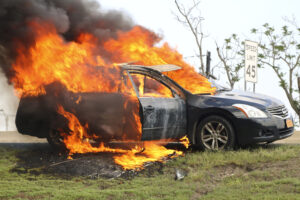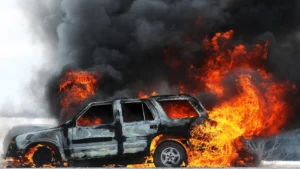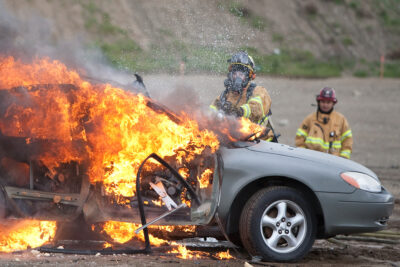A car fire accident is one of the most dangerous types of accidents. If you are involved in a car fire, it is important that you understand the risks and how to handle them. The question most victims as is my car caught on fire what now report shows that most victims do not know what to do in the first few minutes of a car fire accident.
You have to stay calm and don’t panic so that you can make the right decision, such as reaching out to your fire extinguisher. The next thing to do is to call your state or local fire emergency support center or 911. You can reduce the impact of the burn with your fire extinguisher before their arrival.
Please note that panic is not one of the things that will help in this situation. Lots of people have lost their cars even while they have a fire extinguisher. But they couldn’t use it because they got overwhelmed to the point that it never crossed their mind. I was almost a victim of this.
What do you do if your car is on fire?

You may have heard the phrase “you can’t put out a grease fire with water.” Well, that’s not entirely true. But let’s talk about what to do if your car is on fire.
First and foremost, keep yourself safe. If there are any people or animals in your car, get them out first. Make sure everyone is out before you try anything else.
Here are some of the things you have to do If your car is on fire:
-
Don’t panic
You can only make the situation worse if you get to start panicking at the sight of the fire. Yes, it is a normal thing to do, but it does affect your sense of judgment or decision and can be costly. So, you have to stay calm as that will help you think straight and make the right choice.
-
Get everyone out of the car
You should act as fast as possible to get everyone out of the car if you have your friend or family with you. You should get out of your seatbelt and find your way out as soon as possible. Ensure you pick your mobile and other resources you have, especially if you have your pets with you.
-
Switch off the ignition
Before you finally make your way out of the car, you need to switch off the ignition of the car. Do that, and then remove the key from the ignition port.
-
Open the bonnet
You should head straight to the bonnet and disconnect the battery. If you still have it connected, it can make the situation worse. You need to start with the negative terminal and then with the positive. Just ensure you disconnect the battery.
-
Reach out to your fire extinguisher
There is a safety policy that guides all car owners, and it is that you must have a fire extinguisher. No one wants the bad to happen, and when it does, the fire extinguisher will be there to save you the stress. You should get the fire extinguisher and apply it.
It will help to reduce the fire burn till fire support comes to your rescue. Also, it is important that you know the right way to use the fire extinguisher.
-
Call 911
You should call 911 and report the incident to them, and they will ask for your location to help you.
-
Take pictures
You need to take a picture of the accident as it is needed to show your insurance company if you have one. They will come to your rescue by paying for the repair or getting you a new car if possible.
Can you fix a car that catches on fire?
Yes, you can fix a car that catches on fire. If the fire is small and contained to the engine, it is possible to put out the flames using a CO2 extinguisher. Make sure to cover your eyes and keep your face away from the fire, but be sure not to touch any metal parts of the engine with your bare hands as you could get burned.
If you can’t put out the fire yourself, call 911 immediately and get everyone out of the vehicle. The fire department will come to put out the flames and make sure that everyone is safe.
You may be able to salvage some parts from your car if they’re still functional after they’ve been exposed to heat or flame.
If not, consider buying new parts at an auto shop or online (we recommend purchasing them through Amazon). You’ll need to replace any part that has been damaged by heat or fire with something that’s comparable in size, strength, and durability to what was originally there before.
What causes a car to catch fire?
There are several things that can cause a car to catch on fire. The most common is a malfunctioning catalytic converter, which converts harmful gases given off by the engine into less toxic ones.
Other causes include faulty wiring, overheating, and oil leaks. If you’re having trouble with your car catching on fire, it’s best to take it to a mechanic as soon as possible.
Here are some of the most common:
-
Poorly maintained engine
A car catches fire when the engine overheats. The primary reason for engine overheating is a lack of proper maintenance. It is recommended that you have your vehicle regularly serviced, including oil changes and coolant changes.
Another common cause of engine overheating occurs when a vehicle’s coolant is contaminated with water. In this case, it may be necessary to drain and refill the radiator with a clean coolant. Keeping your car well maintained can help to prevent engine fires and save money over time by preventing breakdowns caused by poor maintenance.
-
Fuel leak or overflow
Fuel system leaks are one of the most common causes of vehicle fires and nearly always occur after a collision. Fuel systems have very specific components that work together to deliver fuel to your engine in the safest manner possible.
These components include lines, filters, and other critical parts that keep fuel contained within the tank. A broken line or damaged filter can cause gasoline or diesel to leak or spill out of the tank and onto hot engine parts, causing a fire.
-
Electrical system failure
Electrical system failures are the most common cause of fires in vehicles. This can happen when wiring is faulty or loose, allowing the flow of electricity to come in contact with the vehicle’s frame or other metals. This sparks a fire.
The next most common cause of vehicle fires is a problem with a vehicle’s heating and cooling system that causes an engine spark which ignites combustible materials near it.
Sometimes drivers do things that cause these issues themselves, like leaving portable electronics in the car while they run errands or failing to properly dispose of cigarettes.
-
Overheating Catalytic Converters
A car fire can occur when the catalytic converter, which under normal circumstances is designed to become red hot, overheats and actually catches on fire.
Although the source of the heat can be tricky to pinpoint, one likely source is an engine with over-faulty spark plugs. If a malfunction occurs with your vehicle’s spark plugs, you may notice that your car is consuming more fuel at idle than it did when you first purchased it.
-
Mechanical problems
Mechanical problems could be causing your car to catch fire. There are several ways that a mechanical issue can cause your car to catch on fire. A loose bolt, faulty wiring, or a bad spark plug could be among the many causes of mechanical issues.
-
Car Crashes
A car crash can cause a car to catch fire in several ways. First, the part that comes in contact with the road (such as the crumple zone, bumpers, and hood) may break apart or become damaged.
This can expose the motor and other parts to sparks from friction and close proximity to other burning parts of the car. In addition, when cars collide, there is an increase in pressure which makes it more likely for gas tanks to rupture and catch fire.
-
Arson
Arson is a crime of deliberate, malicious, and (usually) sudden destruction by fire. It’s a felony in most states, with punishments ranging from fines and community service to life imprisonment. While arson is most often associated with burning down buildings, it covers all kinds of fires as arsonists have been known to burn down cars, trucks, and even spaceships.
-
Overheating Engines
Overheating engines are a common cause of car fires, and the automobile engine’s heat source is a perfect place for a fire to take hold.
The engine itself may overheat due to the engine being in an enclosed space with very little airflow or because of an overheated water pump. In either event, the oil inside the engine will heat up, as well as any other fluid that might be present.

Can you put water on a burning car?
Yes. Contrary to popular belief, you can put water on a burning car. The reason why it’s believed that you shouldn’t do this is that putting water on fire will only make it worse and cause more damage. However, if you have the right tools and know what you’re doing, then putting water on a burning car is perfectly fine.
The best way to put water on a burning car is by using a fire extinguisher, which is designed specifically for putting out flames in cars or buildings. You can also use sand or baking soda to put out the flames as well.
Will the car explode if on fire?
A car will explode if it’s on fire, just like anything else. The exact reason this happens is a little more complicated. When you have an engine inside your car, there are many different components that can catch fire or explode. This includes the fuel pump, the fuel lines and filters, and the spark plugs.
If any of these parts catch fire, then the gas vaporizes and expands rapidly in a huge explosion. This causes all kinds of damage to the surrounding area, including your car’s body and other parts that may have been damaged already by an accident or another fire.
Can you pour water on an engine fire?
Yes, you can pour water on an engine fire. The first thing to do is make sure you aren’t in a position to get burned yourself. If you’re in the car or near it, get away. Then, turn off any electrical sources that might be contributing to the fire. If there’s something like a battery under your hood that’s causing the fire, disconnect it.
Now comes the serious part: pouring water on the flames. Be careful not to get too close; the flames can burn you even if they’re not touching you.
Pour slowly and steady so that all of the flames get wetted down, but don’t pour so much that you flood out your engine compartment or cause water damage inside of it.
What do firefighters use to put out car fires?
There are three main ways firefighters put out car fires.
The first is to use CO2, which is carbon dioxide. This is a highly-pressurized gas that’s stored in cylinders and then released when it’s needed.
The second option is to use water, which is also pretty common.
A third option is a foam, which consists of a high concentration of water mixed with a chemical called sodium bicarbonate.
How long does it take for a car to burn?
It depends on the car, and it depends on the fuel. In general, a car that is made of steel will take about 15 minutes to burn completely, as long as there’s plenty of oxygen in the air. If you want to make sure it burns completely, though, you’ll need to ignite it with something like gasoline or kerosene.
A car that’s made of aluminum should take about 45 minutes to burn completely; this kind of material doesn’t burn as easily as steel does.
If you’re trying to dispose of an old car and want it to go up in flames quickly and completely, consider using gasoline or kerosene.
What temperature does a car fire reach?
The temperature of a car fire can reach up to 2,000 degrees Fahrenheit. However, the average temperature of a car fire is only 1,000 degrees Fahrenheit.
Are car fires investigated?
Yes, car fires are investigated. The National Fire Protection Association (NFPA) has published a standard for vehicle fire investigations and recommendations for their use. The NFPA investigation team consists of three members: an investigator, a recorder, and an estimator.
The investigation is conducted according to the NFPA standards, which include:
- Establishing the scene perimeter and controlling access to it
- Identifying potential hazards at the scene
- Confirming that all personnel are evacuated from the area around the fire
- Ensuring that proper personal protective equipment is worn during operation and cleanup operations
- Properly marking all items so that they can be identified later
What causes a car to catch fire in an accident?
There are two main causes of a car catching fire in an accident: the fuel system and the electrical system.
The fuel system is comprised of the fuel tank, fuel pump, carburetor/fuel injection system, and engine parts that interact with or contain fuel.
The electrical system is made up of wiring, fuses and relays, ignition components like spark plugs and distributor caps, as well as other electrical components like battery cables, voltage regulators, and starter motors.
When a car crashes at high speeds or suffers significant damage to the body panels (i.e., doors), the metal fragments may puncture the fuel tank or other parts of the vehicle’s power train (like engine blocks).
This allows gasoline vapors to escape into the air inside your car’s passenger compartment, where they can build up over time until they ignite into flames when exposed to a spark from an electrical short circuit or hot exhaust manifold (which occurs when too much heat builds up inside your engine compartment).
Where do most vehicle fires start?
The most common place for vehicle fires to start is in the engine compartment. This can be due to a faulty electrical system, or it could be because of a fuel leak or overheating.
Other common places for a fire to start include:
- In the trunk or cargo area
- Under the hood (or bonnet)
How to treat yourself from car fire burn?
When you suffer a car fire burn, it can be easy to panic. But don’t. We’ve got some great tips for how to treat yourself from a car fire burn.
1. First, apply cool water to the injured area for 15 minutes. This will help reduce swelling and ease the pain. You can use a damp cloth or a bag of ice to achieve this effect.
2. Next, try applying an antibacterial ointment or cream to the injured area. The cream will help prevent infection and keep the wound clean while it heals.
3. Lastly, keep an eye on your burn as it heals. If it looks like it’s getting worse instead of better, or if it starts oozing pus, you should probably see a doctor right away.
Note: It is safe you get to your doctor for intensive care if you suffer any fire burn.
Symptoms of a car fire burn on the skin?
The symptoms of a car fire burn on the skin can be mild or severe. They depend on the extent of the injury and what part of your body was affected.
In general, if you’ve been burned in a car fire, you’ll likely experience:
1. Pain at the site of the burn, which may be sharp or burning.
2. Redness and swelling in the area around the wound which is also likely to be painful.
3. The burning sensation may also be accompanied by other symptoms, including blisters and discoloration of the skin.
4. The severity of these symptoms depends on the severity of the fire and how long it took to extinguish it. If you were able to put out your car fire quickly, then you may not notice any symptoms at all.
The danger of inhaling fire burn smoke
Fire can be an exciting and exhilarating experience, but it’s important to know the dangers of inhaling fire burn smoke.
There are many risks associated with inhaling fire burn smoke, including:
- Reduced lung function
- Respiratory problems
- Coughing fits
- Asthma attacks
The most common symptoms are coughing, wheezing, and shortness of breath. These symptoms can be treated with over-the-counter medications such as cough drops, decongestants, and expectorants.
However, there is also some evidence that breathing in smoke can cause more serious health problems like cancer or heart disease. In order to prevent this from happening, it is recommended that people stay inside during periods when air quality is poor due to wildfire activity nearby.
Conclusion
This page gives a solution to the question: my car caught on fire what now? Fire can be a terrifying thing. The suddenness of it, the heat, and the sheer amount of energy released are all things that can make it difficult to stay calm.
It is so important to stay safe during a car fire burn. If you’re not careful, you can find yourself trapped inside a burning vehicle, unable to get out on your own, and forced to wait for help to arrive. You should always try to find your way out of the car and then call for help if you can’t put out the fire with an extinguisher.


